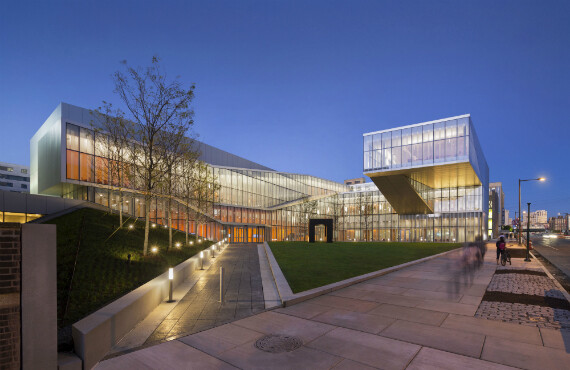Penn Celebrates Opening of Krishna P. Singh Center for Nanotechnology
The University of Pennsylvania will officially open the region’s premier facility for advanced research, education, and innovative public/private partnerships in nanotechnology on October 4. The 78,000 square-foot Krishna P. Singh Center for Nanotechnology will serve as the University’s focal point for groundbreaking work in the emerging field of nanotechnology, which involves the manipulation of matter on an atomic and molecular scale.
The potential benefits of nanotechnology range from regenerative medicine and targeted drug delivery systems, to innovative new approaches in creating and storing electricity that could virtually eliminate the use of fossil fuels, to highly efficient ways of harvesting fresh water from seawater, to everyday commercial products that make clothes last longer, golf balls fly straighter and personal computers operate more efficiently.
“The Singh Center positions Penn to become our nation's leader in nano-scale science, education and research," said Penn President Amy Gutmann. “This is a stunning building that will bring together eminent Penn researchers and experts in private industry with state-of-the-art laboratories and production facilities. Nanotechnology is a vital field with tremendous momentum and vast opportunities for innovation and positive impact locally, nationally and globally. The Singh Center is a critically important part of Penn’s mission to advance both basic discovery and the application of those discoveries to improve society.”
Faculty from the School of Engineering and Applied Science, the School of Arts and Sciences, and across the University will make use of the Singh Center’s characterization and fabrication suites. Each of the two 10,000-square-foot facilities is filled with state-of-the-art equipment and designed to enable the high-precision techniques that research at the smallest scales necessitates.
The characterization facility is situated on bedrock, 18 feet below the surface, to help minimize vibrations that would interfere with its various atomic and electron microscopes. Its labs are also designed to be isolated from temperature fluctuations, atmospheric turbulence, and electromagnetic noise.
The fabrication facility on the Singh Center’s ground floor contains a next-generation cleanroom. Once in isolation garb, researchers will use its assembly tools to grow carbon nanotubes, deposit graphene, and etch microelectronic systems, among many other applications. The facility’s photolithography equipment is shielded from interfering ultraviolet light by a pane of marigold glass, which gives the Center its signature color.
“Penn’s world-class researchers need world-class facilities to advance their groundbreaking work,” said Eduardo Glandt, the Nemirovsky Family Dean of the School of Engineering and Applied Science. “Likewise, the Singh Center will play a key role in growing our faculty and research expertise for years to come.”
Beyond serving faculty in engineering, physics, and chemistry, the Singh Center was built to spark interdisciplinary inquiry. An inviting gateway at the eastern entrance to campus, the Center is already opening doors to new research throughout Penn’s 12 schools.
“The Singh Center’s facilities will allow researchers from a range of fields to analyze structure in the finest possible detail, from anthropologists working with ancient artifacts to biomedical researchers developing therapeutic molecules,” said Steven Fluharty, dean of the School of Arts and Sciences. “Its impact will be felt far beyond the field of nanotechnology.”
The Singh Center will also help Penn-developed technology move from the lab to the marketplace via connections with local industry development leaders such as the Nanotechnology Institute and Ben Franklin Technology Partners, as well as Penn’s internal commercialization engine, the Center for Technology Transfer. Existing industry members, from pharmaceutical companies to computer chip designers, will also make use of the Singh Center’s characterization and fabrication facilities.
“The Singh Center is one of the few places in the world where you can find this kind of equipment and expertise in the heart of a major metropolitan city,” said Mark Allen, the Singh Center’s scientific director. "In addition to enabling world-class research and providing outstanding educational opportunities in nanotechnology, we aim to be a two-way street for entrepreneurship and innovation.”
The building was designed by Weiss/Manfredi Architecture/Landscape/Urbanism, a multidisciplinary design practice based in New York City. Founded by Marion Weiss and Michael Manfredi, Weiss is the Graham Chair Professor of Architecture in Penn’s School of Design. The team’s challenge was to create a building that evoked the mathematical precision of nanotechnology while being integrated into the large scale of Penn’s urban campus. The results have been met with resounding praise from the architecture world: The Singh Center has already won a 2013 American Architecture Award and a 2013 International Architecture Award, presented by the Chicago Athenaeum Museum of Architecture and Design and the European Centre for Architecture Art Design and Urban Studies.
The Singh Center was made possible by a $20 million gift by Krishna P. Singh. Singh is the founder, president and chief executive officer of Holtec International in Marlton, N.J., an energy-technology company he established in 1986. He is a member of Penn's Board of Trustees and the Engineering Board of Overseers and has served as an adjunct professor of mechanical engineering at Penn. He received his Ph.D. in mechanical engineering in 1972 from Penn and a master's in engineering mechanics in 1969, also from Penn.








